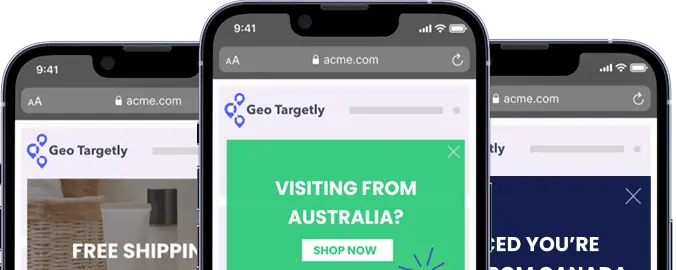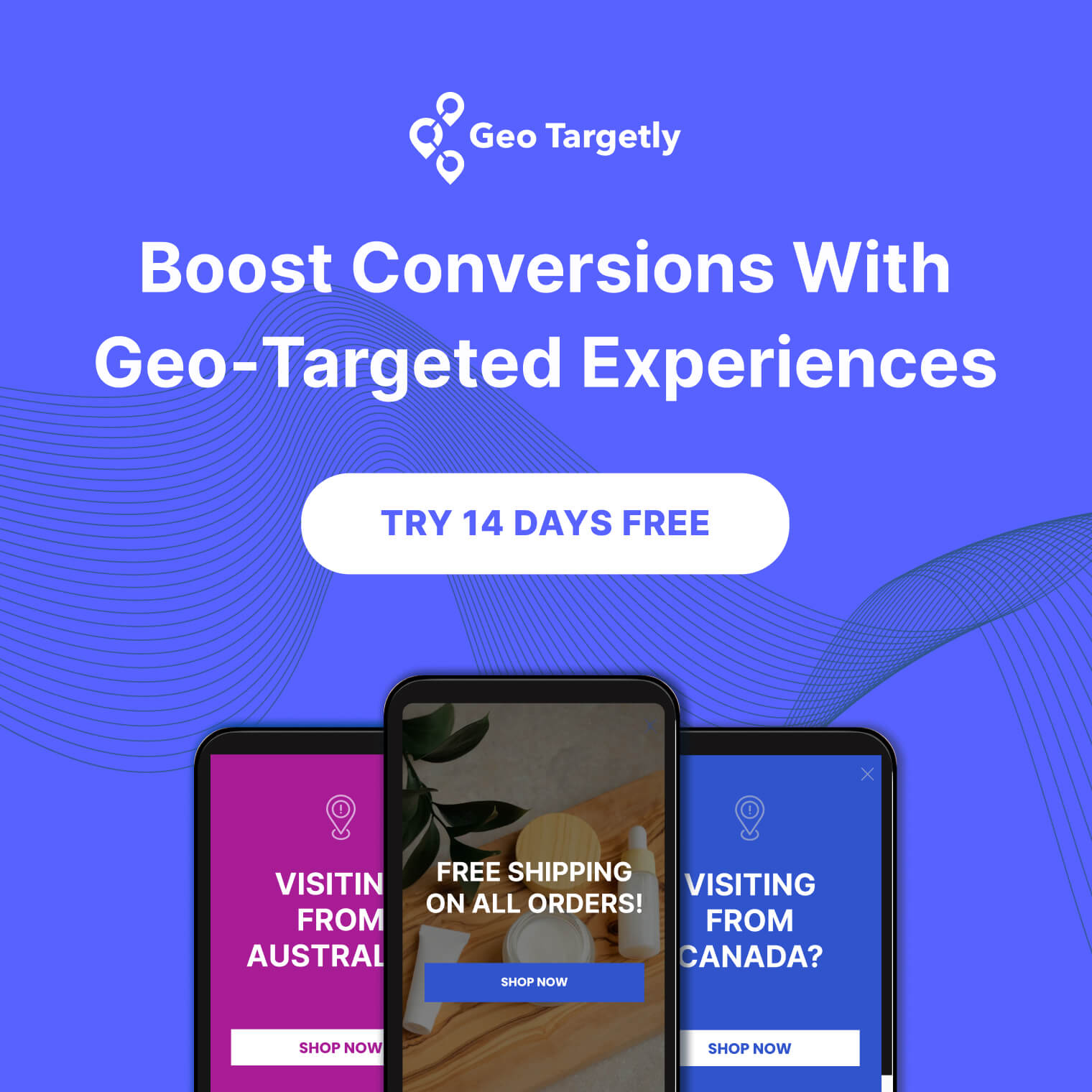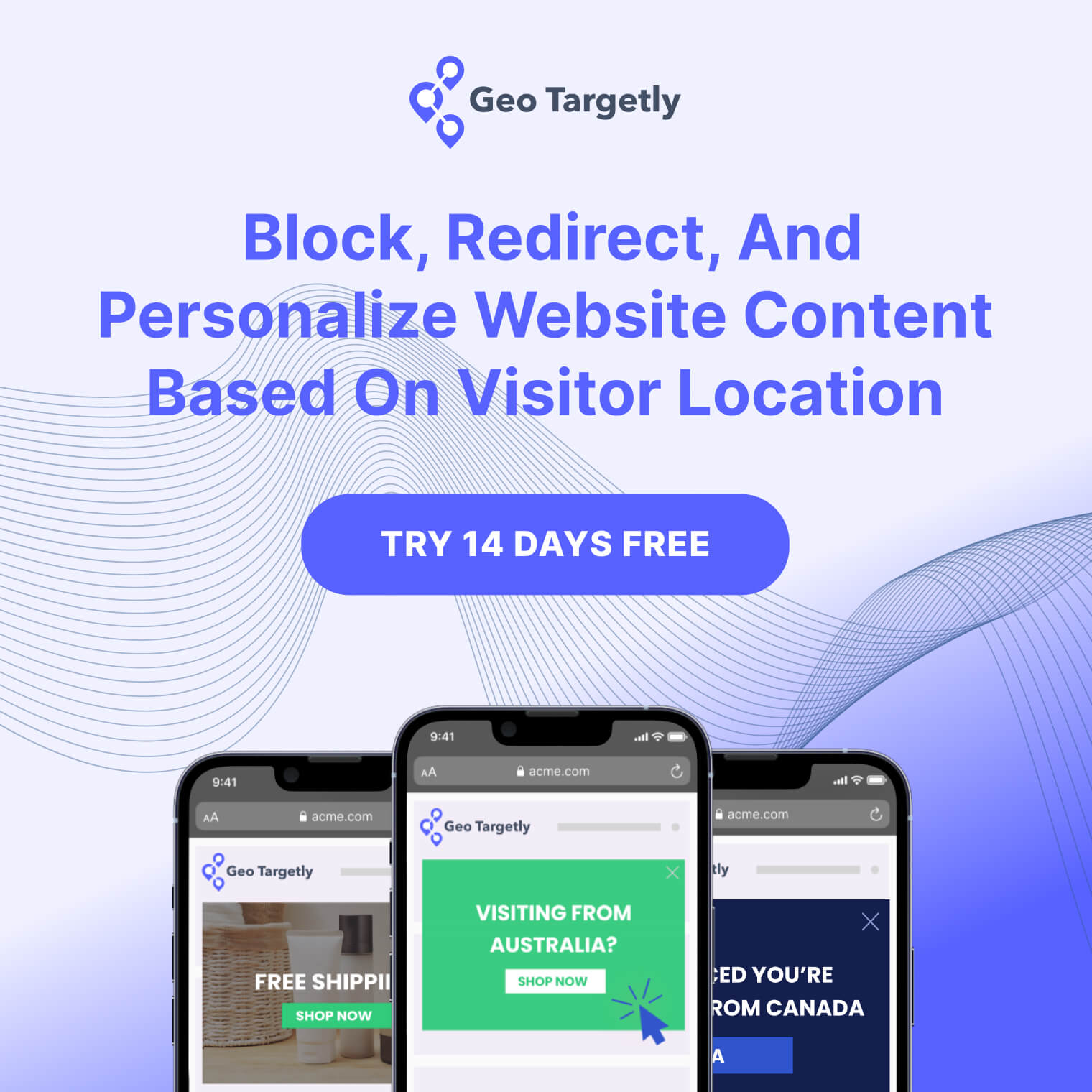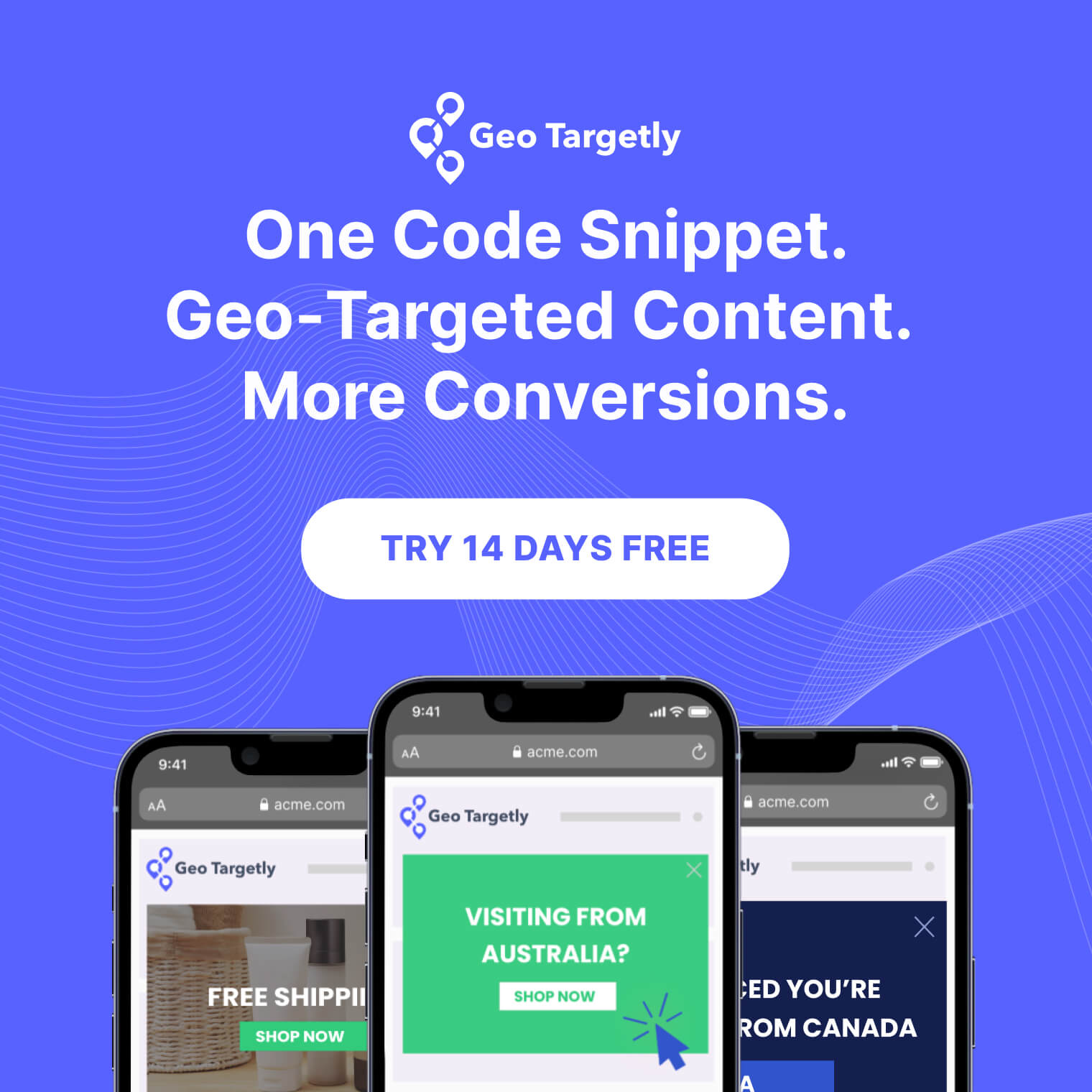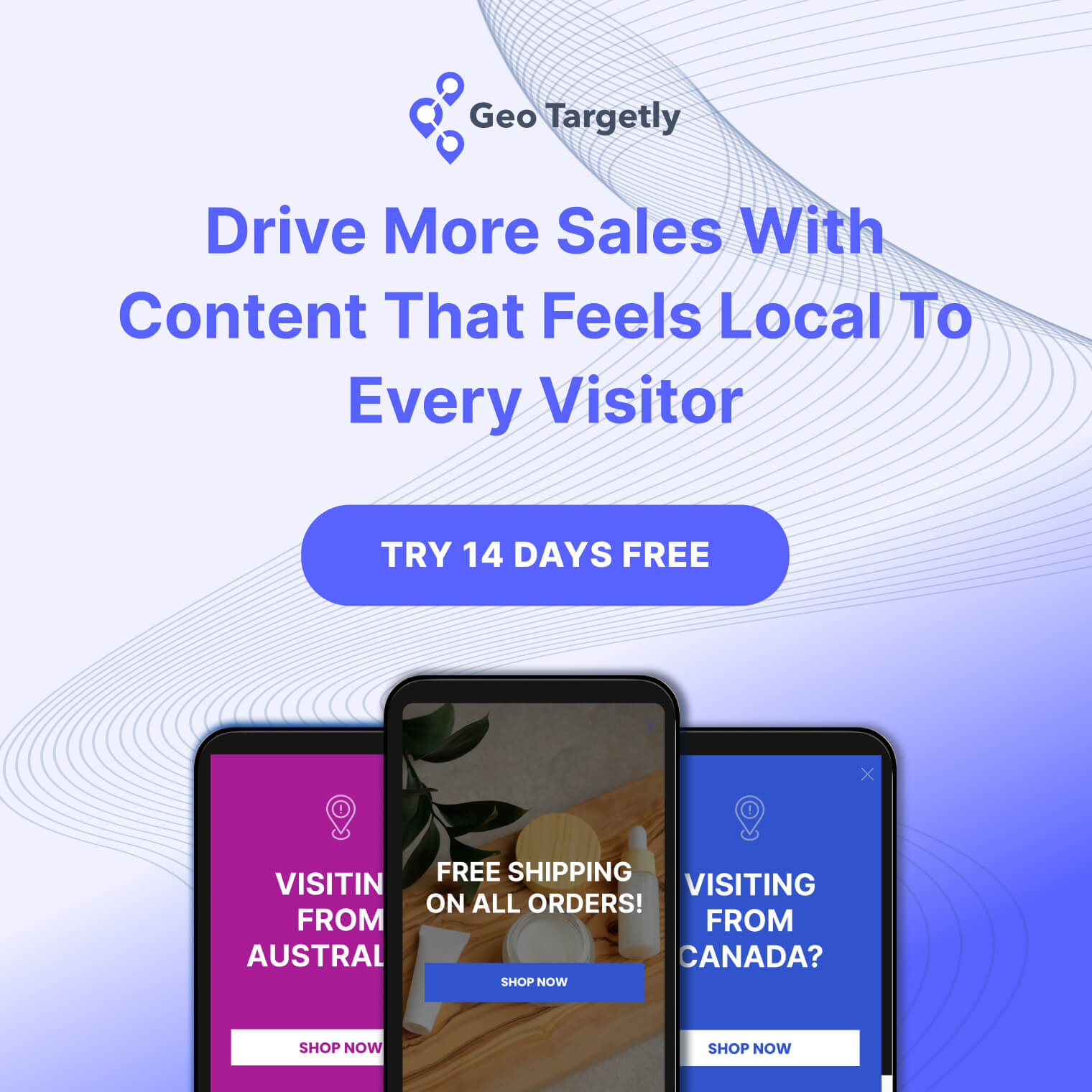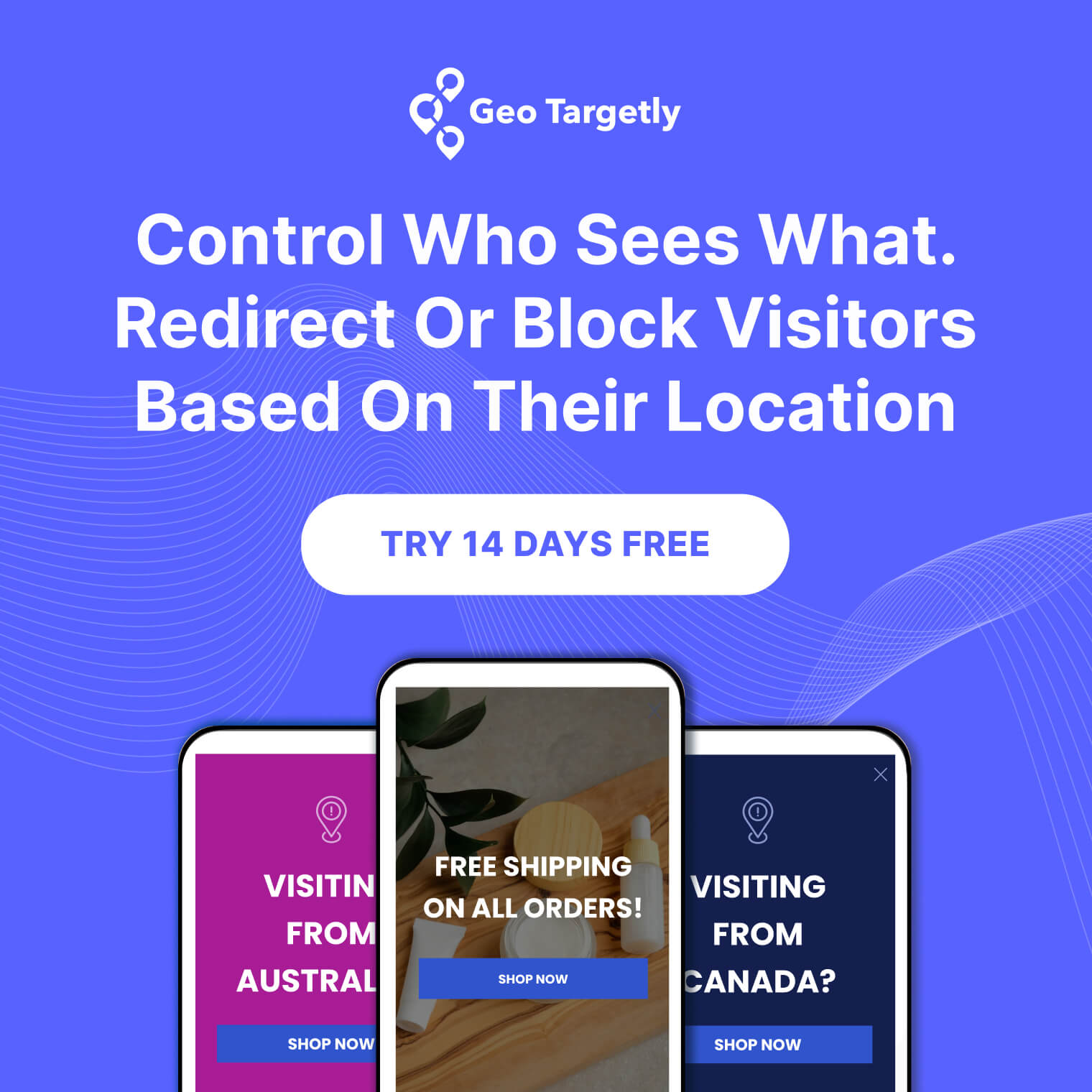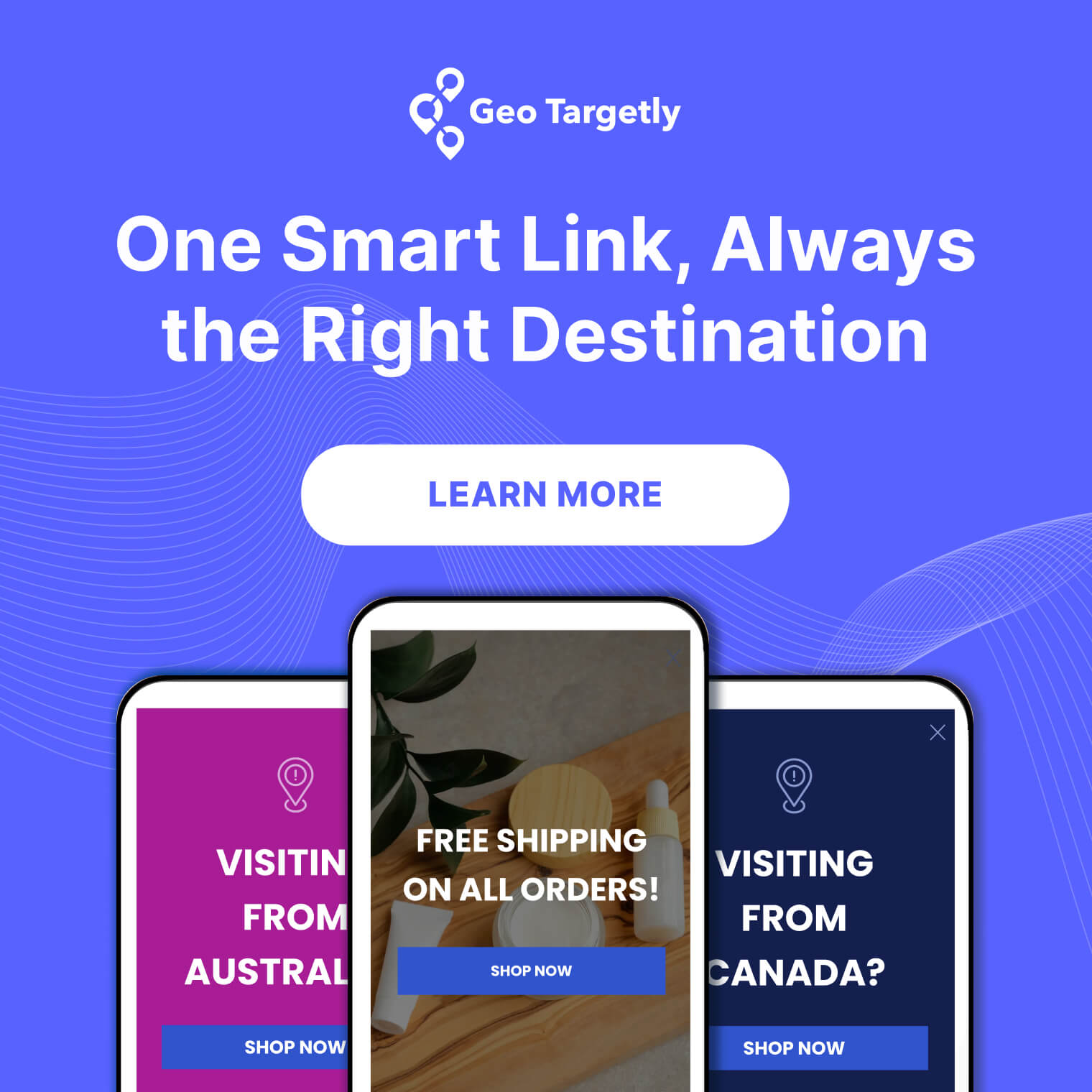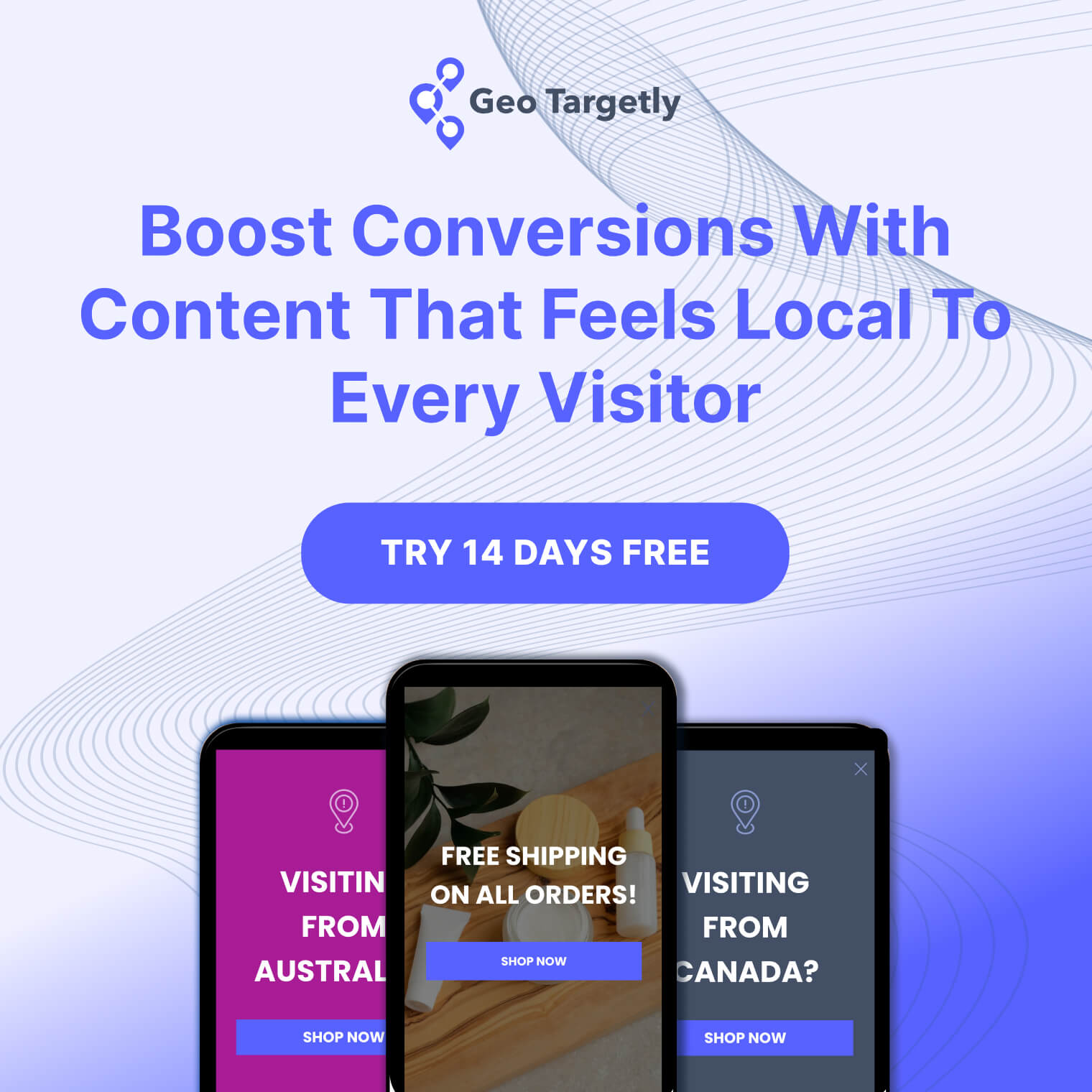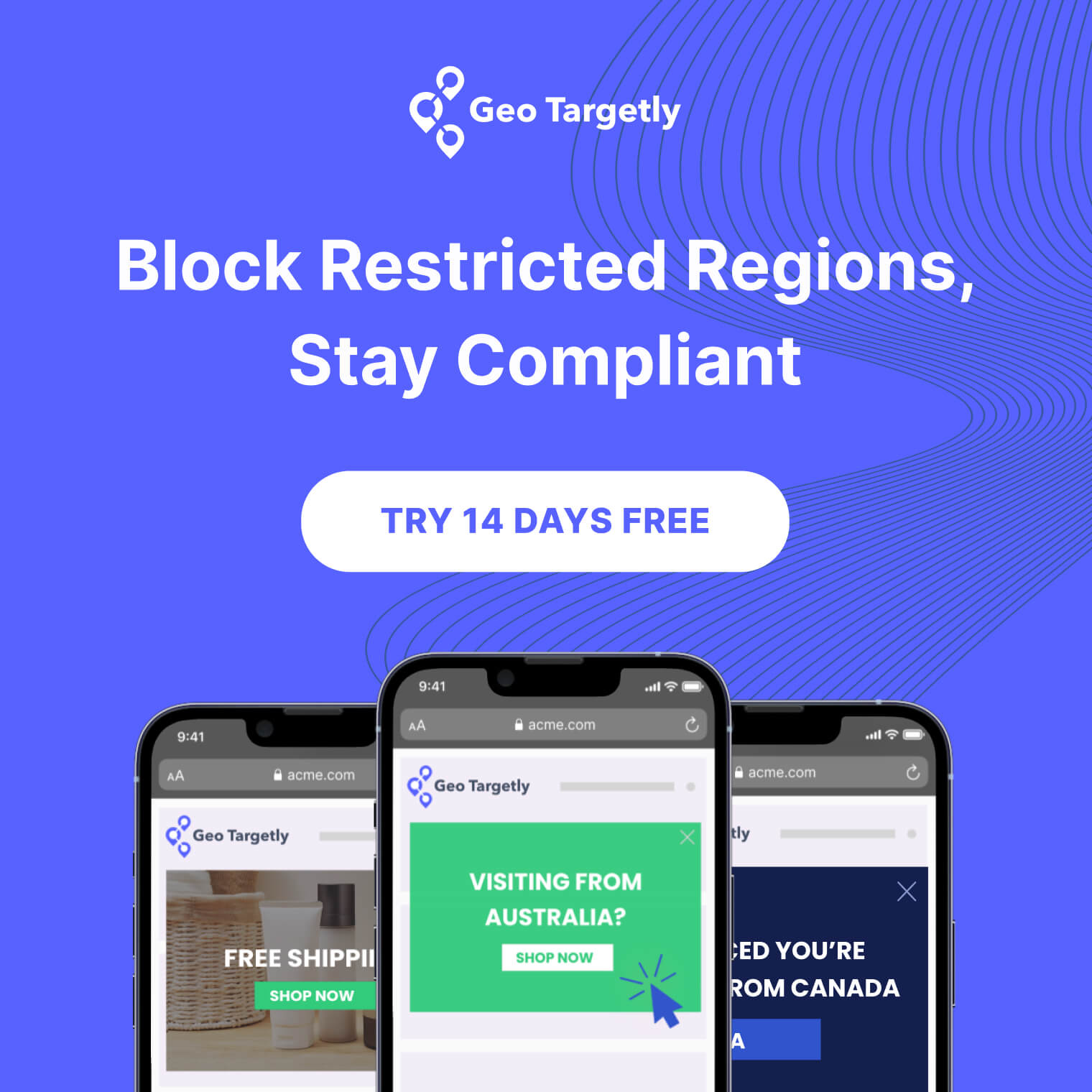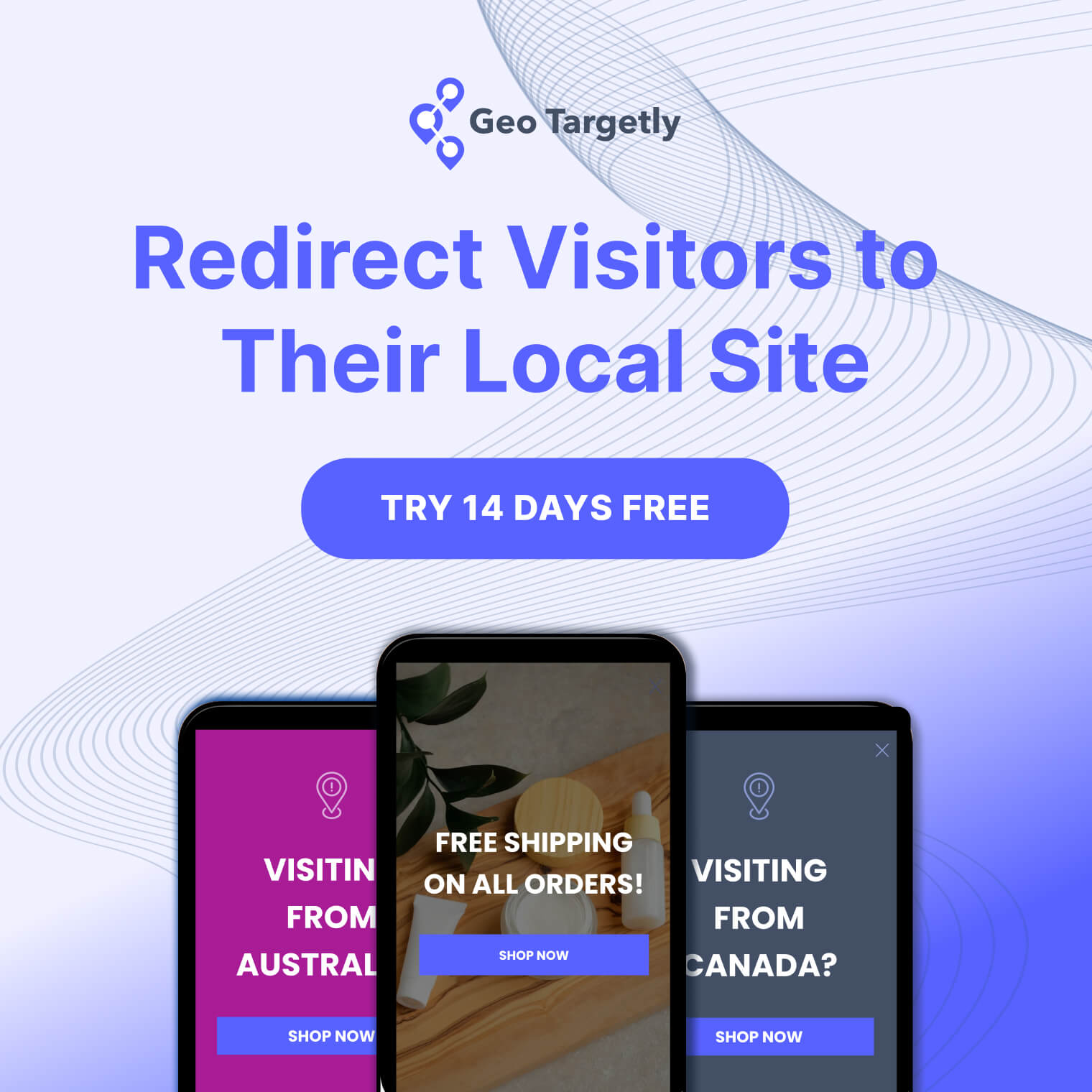

Key Takeaways
- Geo-targeting SEO goes beyond local SEO by delivering personalized content based on user location, improving relevance and boosting conversions.
- Creating unique, region-specific landing pages increases visibility and engagement, just avoid copy-pasting the same content with different city names.
- Use tools like Google Business Profile, schema markup, and hreflang tags to optimize for local and international audiences effectively.
- Respect user privacy and preferences. Don’t auto-redirect based on IP without consent, and stay compliant with General Data Protection Regulation (GDPR) or California Consumer Privacy Act (CCPA) when using location data.
Effectively reaching customers in specific locations is important for businesses, ranging from local shops to international e-commerce brands. Geo-targeting SEO offers marketers effective strategies to boost local visibility, attract more relevant traffic, and substantially increase conversions.
By aligning your SEO efforts with your audience's geographic needs, your brand can provide personalized experiences that enhance user satisfaction and yield tangible business results.
In this guide, we'll walk you through key factors you need to know about geo-targeting in SEO. You'll gain insights into best practices, common pitfalls, essential tools, and actionable tips to turn location-based optimization into a decisive competitive advantage.
What is geo-targeting in SEO?
Geo-targeting in SEO refers to the practice of delivering specific website content or ads to users based on their geographic location.
Unlike traditional local SEO, which primarily targets visibility in local search results through tactics such as Google Business Profile optimization and local citations, geo-targeting extends this approach by dynamically customizing content according to the user's actual location or regional context.
To make geo‑targeting practical at scale, some sites use a generative engine optimization tool to create tailored content variants automatically. This allows each page to feel customized for its audience without manually writing dozens or hundreds of slightly different versions. By incorporating relevant data and context, the resulting content aligns more naturally with what users expect. This relevance can improve engagement, lower bounce rates, and signal to search engines that the content is genuinely useful. Over time, building and maintaining these versions strengthens a site’s ability to rank well across multiple areas.
While both geo-targeting and local SEO aim to enhance local visibility, they differ in their implementation methods. Here's a much-cleared breakdown:
With that said, geo-targeting opens up a broader application in the field, including:
- Local stores targeting neighborhood or city-specific promotions.
- International brands deliver localized content in multiple languages or currencies.
- Franchises manage consistent yet locally tailored messaging across various locations.
- E-commerce platforms showing region-specific product availability, pricing, and delivery information.

Why geo-targeting SEO matters
Geo-targeting SEO matters because it helps enhance your digital strategy. Let's take a look in detail at the advantages it provides:
- It brings in more relevant traffic. Instead of sending the same message to everyone, geo-targeted content speaks directly to users based on their location. Someone searching for "roof repair in Dallas" should land on a page that addresses roofing issues specific to Texas weather, not a generic roofing service page.
- Delivers a better user experience (UX). Personalized content removes friction. When a visitor sees pricing in their local currency, location-specific offers, or service availability tailored to their area, it instantly builds trust. They don't have to guess or dig for the info they need; it's already there.
- Improves click-through rates (CTR). Geo-targeted titles and meta descriptions stand out in the SERPs. A phrase like "Top-rated dog groomer in Brooklyn" performs better than a vague "Professional pet grooming." Users may click when they feel a result is tailored to them.
- Boosts conversions. With better alignment between search intent and landing page content, visitors take action, whether that's booking a service, making a purchase, or filling out a form. Relevance drives results.
- Supports Google's location-based ranking signals. Google personalized search results based on location. If your content is optimized for regional keywords and tailored to local experiences, it's more likely to appear in localized searches, giving you a competitive edge.
- It helps businesses scale smarter. For brands operating across multiple locations, geo-targeting enables you to maintain a consistent brand voice while tailoring content to local nuances, such as language, shipping details, or cultural context.
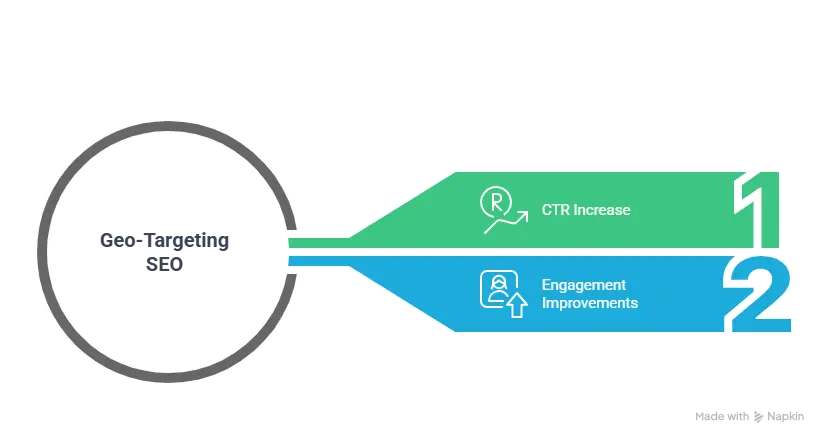
Using geo-targeting for local SEO: A step-by-step guide
To effectively integrate geo-targeting into your SEO strategy, a structured approach is essential to avoid potential complexities. Below is a step-by-step guide that outlines the process for optimizing your online presence for location-based search queries.
1. Do keyword research with local intent
Local keyword research is the foundation of geo-targeting SEO. The goal here is to identify what people in specific regions are typing into search.
There are two types of local search terms to look out for. Some include the location directly, like "emergency plumber in Miami" or "divorce lawyer Chicago." These are easy to spot.
Others are more subtle, like "best pizza near me" or "dry cleaner open late." Even though they don't mention a place name, Google still treats them as local queries by factoring in the user's real-time location.
Both types matter. Ignoring either one means you're missing out on valuable traffic, especially from people who are ready to take action.
When conducting keyword research for geo-targeting, focus on identifying high-intent, location-aware phrases.
These are the kinds of searches that typically come from users who are closer to making a decision, whether that's booking a service, visiting a store, or making an online purchase.
To refine your keyword list even further, analyze search volume variations across different neighborhoods or ZIP codes, since intent often shifts within the same city."- says Maria Harutyunyan, CEO of Roofing SEO Agency. "Look for patterns in related queries and People Also Ask data, which can reveal hidden local pain points you can target. And always compare desktop vs. mobile search behavior, mobile users tend to perform more urgent, location-dependent searches, making those keywords particularly valuable." she adds.
Here are some go-to tools that can help you uncover those keywords:
- Google Keyword Planner: Filter keywords by location to see which terms are popular in your target city, region, or country
- Google Search Console: Check the "Performance" report to see which queries already bring in local traffic and how they perform by CTR and impressions
- Ahrefs: Explore location-specific keyword ideas, look at competitor pages for different cities, and analyze long-tail local phrases
- Semrush: Use the Keyword Magic Tool and Location reports to find relevant, high-intent terms with clear geographic intent.
- Mangools KWFinder: Find long-tail keywords with low SEO difficulty and exact search volumes. Its intuitive interface and competitor analysis features make local keyword research fast and simple
Once you've collected your list of keywords, prioritize based on intent and location relevance. For example, "family dentist" is a very broad and competitive term. A better approach would be to go after more specific phrases like:
- "family dentist in Austin"
- "Austin Dental Clinic accepting new patients."
- "best dentist for kids in South Austin"
These long-tail variations may have lower search volume, but they come with much higher intent. This means more conversions when your content shows up in front of the right user.
Also, consider creating keyword clusters by city, neighborhood, or region, especially if you're managing SEO for multi-location businesses. This will help you plan out localized landing pages and blog content that's both useful to users and optimized for search.
At this stage, avoid falling into the trap of targeting the same keyword in every city. Each area has its nuances, search behavior, and pain points. Your job is to reflect those differences through authentic, well-researched local terms, not just swap city names in and out.
2. Optimize your google business profile
Your Google Business Profile (GBP) is a powerful asset for geo-targeted SEO, especially if you want to appear in local map packs, "near me" searches, and voice queries. It's also one of the easiest places to win visibility, but only if it's set up and managed correctly.
Many businesses claim their profile and never touch it again. That's a missed opportunity. Google uses the information in your GBP to decide if and when to show your business in local results. The more complete, accurate, and active your profile is, the more you are to rank well for relevant searches in your area.
Here's how you can optimize your Google Business Profile:
- Ensure your core details are accurate and consistent: Use your real-world business name (no keyword stuffing), match your address exactly with your website and citations, list a local phone number (not a toll-free or call center line), and link to the most relevant landing page for that location.
- Avoid inconsistent NAP (name, address, phone) data: Google may not trust your listing if your information differs across platforms, such as Yelp, Apple Maps, or Facebook. Utilize tools like Moz Local or Whitespark to audit and refine these citations.
- Select the appropriate categories and attributes: Your primary category should align with your core service (e.g., "Pediatric Dentist" or "Vegan Restaurant"), and you can add secondary categories for related offerings. Attributes like "Black-owned," "Wheelchair accessible," or "24/7 service" help users filter results and may appear in search results.
- Set up specific service areas if you don't have a storefront: If you operate in multiple neighborhoods, cities, or zip codes, manually add those areas to the GBP dashboard. This is particularly important for service-based businesses, such as plumbers or landscapers.
- Keep your business hours accurate and up to date: Even though it may seem minor, incorrect hours are another way to lose trust. And they can lead to negative reviews if a customer shows up and finds you closed.
- Treat your profile like a social feed, not a static listing: Add high-quality photos of your storefront, post weekly updates, highlight seasonal promotions, and respond to reviews to show both Google and customers that you're active and engaged.
- Understand the value of an optimized GBP: When done right, your profile helps you rank and build credibility, answers key questions at a glance, and drives real-world actions like calls, visits, and conversions.
3. Create region-specific content
If you want to rank in multiple areas, you need content that speaks directly to each audience. Region-specific content helps you connect with users in their local context, builds relevance in Google's eyes, and boosts conversions.
This doesn't mean creating dozens of nearly identical pages with "copy + paste" content and swapping out the location. Google's algorithms are smarter than that. Instead, every location-specific page should feel genuinely tailored, as if it were written with that city or audience in mind.
Begin by identifying the areas that matter most to your business. That could be:
- Cities where you have physical locations
- Service zones you cover (such as zip codes or neighborhoods)
- Markets you're expanding into
- Regions with different language, pricing, or cultural expectations
Once you've identified those areas, create content that reflects the needs, language, and search behavior of people in each location.
This can take the form of:
- City-specific landing pages – "Roof Repair Services in Denver" or "Catering in Downtown Chicago."
- Localized blog content – "Best Wedding Venues in Atlanta We've Catered For."
- Regionally focused FAQs – "Do you deliver to Hoboken?" or "What's your snow removal policy in Minneapolis?"
- Customer stories or testimonials from that region – mentions of local landmarks, events, weather conditions, or community involvement
The key is relevance and authenticity. Don't just reword the same paragraph across 10 cities. Think about what matters to people in each location. What questions are they asking? What services are in demand? What makes your offering better or different in this regard?
For example, a pest control company might write about seasonal rodent problems in Chicago, termite concerns in Houston, and mosquito issues in Orlando. That's not just good for SEO, it's helpful for users.
Here are a few content elements to consider including on each region-specific page:
- A localized H1 and meta title
- City or region mentioned naturally throughout the text (not stuffed)
- Testimonials or reviews from local clients
- Service area map or embedded Google Map
- Location-specific CTAs like "Schedule a Free Estimate in Scottsdale"
- Internal links to your main services page or about page
Additionally, if your business has multiple locations, be sure to link from your homepage or a store locator page to each regional page. This helps both users and search engines find your localized content easily.
4. Add schema markup for local businesses
Schema markup is often overlooked in local SEO. It doesn't change how your content appears to users, but it tells search engines exactly what your business is, where it is located, and how it should be displayed in search results.
If you want Google to understand your location-specific content better and potentially display rich results, such as ratings, hours, or maps – adding schema is essential.
For local SEO, you should utilize structured data types such as LocalBusiness, Organization, and Place. These help Google connect your website with your real-world presence.
Start with the basics. At a minimum, your schema should include:
- Business name
- Full street address
- City, state, postal code, and country
- Phone number (preferably local)
- Business hours
- Geo-coordinates (latitude and longitude)
- Website URL
- Social media profiles (using sameAs)
- Business type (like Dentist, Restaurant, Plumber, etc.)
Here's a simple example of a LocalBusiness schema using JSON-LD – Google's recommended format:
<script type="application/ld+json">
{
"@context": "https://schema.org",
"@type": "LocalBusiness",
"name": "Bright Smile Dental",
"image": "https://example.com/images/office-front.jpg",
"address": {
"@type": "PostalAddress",
"streetAddress": "456 Main Street",
"addressLocality": "Austin",
"addressRegion": "TX",
"postalCode": "78704",
"addressCountry": "US"
},
"telephone": "+1-512-555-6789",
"url": "https://brightsmileaustin.com",
"openingHours": "Mo-Fr 08:00-17:00",
"sameAs": [
"https://www.facebook.com/brightsmileaustin",
"https://www.instagram.com/brightsmileaustin"
]
}
</script>
You can paste this code into the <head> of your location-specific landing pages (or inject it using a plugin if you're on platforms like WordPress, Wix, or Shopify. Just make sure the details exactly match what's on the page. Inconsistency can lead to markup errors or missed opportunities for rich results.
If you serve multiple locations, each location should have a schema block with its unique address and contact information. Avoid listing five addresses in one schema, that isn't very clear to both users and search engines.
You can test your markup using Google's Rich Results Test or the Schema Markup Validator. These tools will help you verify that your structured data is set up correctly and flag any errors that need to be fixed.
Adding a local business schema doesn't guarantee you'll get rich snippets or map visibility, but it significantly increases the likelihood. This is a low-effort move and it's beneficial when combined with your Google Business Profile and accurate citations across local directories.
5. Use hreflang for international geo-targeting
If your website serves users in multiple countries or languages, you need to use hreflang tags. They help search engines understand which version of a page should appear in each region or language, reducing duplicate content issues and ensuring users land on the most relevant version of your site.
Think of hreflang as a signpost that tells Google:
"This page is for users in the U.S. – here's the same content for users in the U.K. and one for French-speaking users in Canada."
Without hreflang, Google may display the incorrect version of a page in the search results. This leads to higher bounce rates and poor user experience, especially if the content is in the wrong language or currency.
Here's how it works.
Let's say you have three versions of a product page:
- https://example.com/us/product-page (for U.S. customers)
- https://example.com/uk/product-page (for U.K. customers)
- https://example.com/ca-fr/product-page (for French-speaking Canadians)
To set up hreflang correctly, you would add the following tags to the <head> section of each version of the page:
- <link rel="alternate" hreflang="en-us" href="https://example.com/us/product-page" />
- <link rel="alternate" hreflang="en-gb" href="https://example.com/uk/product-page" />
- <link rel="alternate" hreflang="fr-ca" href="https://example.com/ca-fr/product-page" />
These tags tell Google which language-region version of the page to show, depending on the user’s location and browser settings.
Some important best practices:
- Every regional page must reference the others – it’s a two-way signal, not one-way.
- Include a self-referencing hreflang tag (each page should point to itself).
- If you serve the same content to all English-speaking users regardless of country, use a language-only tag, like hreflang="en".
- For users not targeted by any specific version, include a fallback version using hreflang="x-default".
Here’s an example with that included:
- <link rel="alternate" hreflang="en" href="https://example.com/global-product-page" />
- <link rel="alternate" hreflang="x-default" href="https://example.com/" />
If you're managing a large site with multiple languages and regions, you can also define hreflang tags in your XML sitemap instead of on individual pages. This is often more efficient and easier to maintain at scale.
You can test your hreflang implementation using the Ahrefs Hreflang Checker or Google Search Console's International Targeting report.
Want a faster, error-free way to set up hreflang tags? Generate accurate tags in seconds with our free hreflang tag generator tool!
How to create location-specific landing pages for better conversions
Creating a location-specific landing page helps you design a page that resonates with local users and makes it easy for them to take action. A well-optimized local page improves both SEO and conversion rates by offering targeted, relevant information. Here's how to do it right:
Key elements of a high-converting local page
To get the best results, include these core elements on every location-specific landing page:
- Clear, localized headline. Start strong with a headline that includes the location and value proposition. For example: "Top-Rated Emergency Plumbing in Denver – 24/7 Service."
- Local call-to-action (CTA). Customize your CTA to reflect the user's location and urgency. Example: "Schedule Your Free LA Consultation"
- Embedded Google Maps. Show your physical location or service area directly on the page. This boosts trust and improves local SEO signals.
- NAP (Name, Address, Phone) info. Ensure your NAP (Name, Address, Phone) is accurate and consistent with your Google Business Profile. Add schema markup to support it.
- Local testimonials or case studies. Include quotes or stories from real customers in that specific region. This builds credibility and relevance.
- Location-specific content. Talk about local events, neighborhoods, regulations, or issues relevant to your audience. This shows you're not just "present", you're part of the community.
- Fast load times and mobile responsiveness. Local search often happens on mobile. Make sure your pages load quickly and are easy to navigate on small screens.
Mistakes to avoid
Avoid these common errors that can hurt both user experience and rankings:
- Duplicate or thin content across locations. Copying and pasting the duplicate content with only the city name changed can trigger SEO penalties. Each page should be uniquely written and tailored to the specific needs of the reader.
- Keyword stuffing with location names. Mentioning the location naturally in headings, paragraphs, and alt text is great. Repeating it excessively makes your content look spammy and unnatural.
- Missing or inconsistent NAP info. If your contact details differ from those listed elsewhere online, it can confuse users and negatively impact your local rankings.
- Generic CTAs. A button labeled "Click Here" doesn't inform the user of what to expect. Instead, use location-rich action phrases, such as "Book a Free Quote in Atlanta."
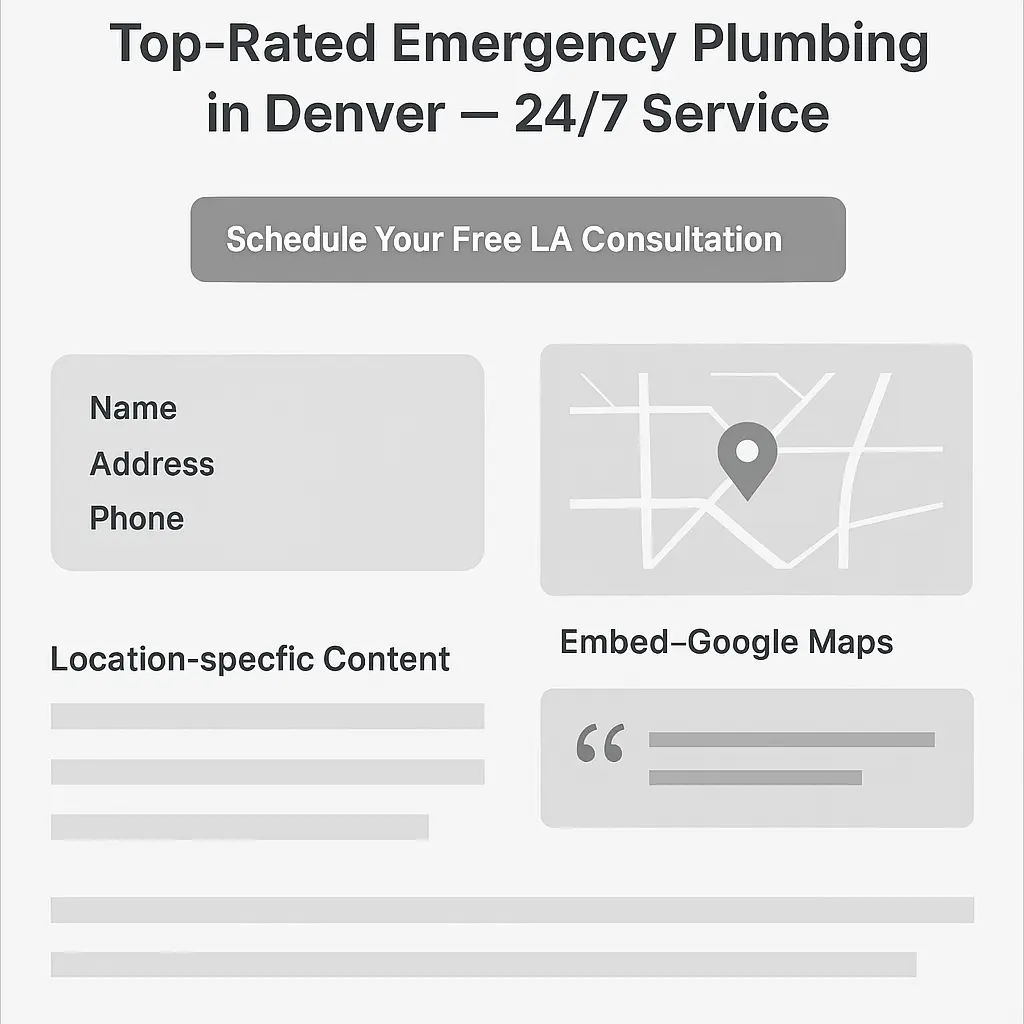
Common mistakes and ethical considerations in geo-targeting
While geo-targeting offers benefits into your SEO strategy and conversions, poor implementation can backfire. Below are some key mistakes to avoid and ethical guidelines to keep in mind.
Inaccurate or overly aggressive IP detection
Automatically redirecting users based solely on their IP address may seem helpful, but it can cause problems:
- Users traveling or using a VPN may get redirected to the wrong version of your site.
- Forced redirection without giving users a choice can reduce usability and increase bounce rates.
- Some users may prefer to view a different region’s content, especially on international or multilingual sites.
Better approach: Use IP detection to suggest the most relevant regional site or content, but never force it. Always provide a visible and intuitive manual location selector, preferably at the top of the page or during the first visit. This puts users in control and reduces bounce rates.
Frustrating location overrides
It’s important to balance automation with control. Automatically overriding a user’s location settings without consent can harm the user experience.
For example, if someone from Berlin wants to browse your US store and you keep redirecting them back to your German site, you create friction that could cost you a sale.
Users often browse across borders. They look for better pricing, product availability, or language preference. When geo-targeting ignores their choices, it signals a lack of user respect and damages trust.
Solution: Once a user selects a location manually, remember their preference (via cookie or session data), and don’t override it automatically. Allow them to easily change regions at any time without being forced back based on IP.
GDPR and consent management
Geo-targeting often uses personal data like IP addresses or GPS info to personalize the experience. But when you’re serving users in the EU (or any region with strict data privacy laws), this can cross into legal risk territory if you’re not transparent and compliant.
Non-compliance with GDPR or similar laws (like CCPA) can lead to fines, legal notices, and loss of user trust. Even unintentionally collecting geolocation data without consent may be a violation.
To avoid it:
- Clearly explain how you use location data in your cookie consent banner and privacy policy.
- Only collect or store geo data when it’s necessary and make sure it’s disclosed.
- Regularly review and update your site practices to stay compliant with GDPR, CCPA, and other applicable laws.
Pro tip: Use geo-targeting tools that support privacy-first implementation. For example, Geo Targetly’s Geo Redirect and Geo Content features allow you to tailor content and user flow based on IP location without storing personally identifiable data, which helps reduce GDPR risk.
If you're running region-specific redirects, consider integrating with Geo Consent. It’s designed to delay location-based actions until the user provides cookie consent. It’s useful if you want to serve location-specific content, while still staying legally compliant.
To try our full suite of tools, be sure to take advantage of our free trial and see the power of geo-targeting for yourself!
Ignoring cultural and language differences
Geo-targeting is contextual. Serving English-only content to users in non-English-speaking countries limits your reach and comes across as tone-deaf. Similarly, using imagery or messaging that doesn’t reflect local norms can alienate audiences.
What this looks like in practice:
- Serving a U.S.-centric page with dollar pricing to users in Japan
- Using humor, idioms, or visuals that don’t make sense (or even offend) in certain cultures
- Overlooking legal or product disclaimers required in specific countries
To avoid that:
- Translate content properly (not with machine translation alone)
- Adjust images, examples, and references to reflect regional culture
- Be sensitive to regional differences in language, currency, units of measure, and legal disclaimers
Tools & resources for geo-targeting SEO
Effective geo-targeting uses the right tools to automate, analyze, and scale your efforts. From keyword tracking to dynamic content delivery, here are some of the most useful platforms and resources for location-based SEO.
Google Search Console – International Targeting
Google Search Console includes an “International Targeting” feature where you can:
- Set a preferred country for your content (useful for country-specific domains or subdirectories)
- Manage and test your hreflang tags
- Monitor any errors or conflicts with your language or regional setup
While it doesn’t handle geo personalization directly, it helps Google understand how to serve the right regional version of your pages.
Google Ads – Location Targeting
Even if you're not running paid ads, Google Ads offers granular targeting insights that can inform your SEO strategy. You can:
- View performance by location
- Identify high-converting regions
- Set up hyperlocal campaigns by city, zip code, or radius
These data points can help guide your content priorities for organic geo-targeting as well.
IP geolocation APIs
To serve dynamic content based on user location, use geolocation APIs that detect a user’s IP address and return region-specific data. These tools are ideal for:
- Personalizing CTAs and banners
- Showing location-based pricing or shipping info
- Delivering the right language or currency automatically
Popular services:
Plugins and apps for CMS platforms
If you're using WordPress, Shopify, or another CMS, there are geo-targeting plugins and apps that make implementation easier – no custom coding required.
For WordPress:
- GeoTargeting WP
- WP Rocket + Cloudflare (for caching + location-based rules)
For Shopify:
- Geolocation app by Shopify
- Multi Country Pricing
These tools let you manage content visibility, location redirects, and country-specific pricing from your admin dashboard.
Geo Targeting SEO Tools: At-a-Glance Comparison
Final thoughts: Geo-targeting as a competitive advantage
Geo-targeting SEO builds meaningful connections with users based on where they are and what they need at that moment. It gives you the power to serve content that feels personal, relevant, and timely.
But this kind of personalization requires more than just adding a city name to a headline. It calls for a strategic approach: localized keyword research, dedicated landing pages, technical setup, and ongoing testing.
Looking ahead, expect geo-targeting to evolve alongside AI and personalization technologies. The businesses that win will be those that combine location data with behavior, preferences, and context, delivering content that feels remarkably intuitive.
If you’re serious about leveling up your local or multi-region SEO strategy, tools like Geo Targetly make it simple to implement location-based personalization. No dev team needed. Just smarter targeting, better conversions, and a user experience that actually feels personal.
👉 Start with one location, test what works, and scale smarter with Geo Targetly.





.webp)



